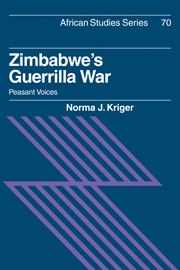Book contents
- Frontmatter
- Contents
- List of maps
- Acknowledgements
- Introduction
- 1 Peasant revolutions: theories and methods
- 2 Inequalities and peasant grievances
- 3 Strategies, goals and appeals: continuity and change
- 4 Guerrilla–civilian relations: the issue of popular support
- 5 Struggles in the struggle
- 6 Legacies of the war for peasants
- 7 Conclusion
- Appendix: Field research
- Notes
- Bibliography
- Index
- Other books in the series
Introduction
Published online by Cambridge University Press: 05 January 2012
- Frontmatter
- Contents
- List of maps
- Acknowledgements
- Introduction
- 1 Peasant revolutions: theories and methods
- 2 Inequalities and peasant grievances
- 3 Strategies, goals and appeals: continuity and change
- 4 Guerrilla–civilian relations: the issue of popular support
- 5 Struggles in the struggle
- 6 Legacies of the war for peasants
- 7 Conclusion
- Appendix: Field research
- Notes
- Bibliography
- Index
- Other books in the series
Summary
Guerrilla wars are the primary form of armed conflict today. They are fought mostly in Africa and Asia and often involve regional and international powers. The far-reaching implications of guerrilla war attract the attention of scholars interested in military issues, international relations, and the relationship between wars and national development. Guerrilla wars have also caught the attention of scholars who work on peasant revolutions. Most anti-colonial and anti-imperial revolutionary wars this century have involved rural-based guerrilla armies. Peasants, widely held to be conservative and parochial, have been prominent in revolutionary guerrilla movements, both as the source of guerrillas' logistical support and as war victims – about 80 per cent of those killed in contemporary guerrilla wars have been civilians. The prominence of peasants in revolutions surprised analysts who had anticipated proletarian revolutions and they turned their attention to trying to understand why peasants participated in these wars. This book is about peasant mobilization by a guerrilla army and internal struggles within the peasantry that motivated peasants to participate in Zimbabwe's anti-colonial war.
Zimbabwe takes its name from the most spectacular of its many stone ruins that were built by indigenous people from the thirteenth century to the fifteenth century. Bounded by the Zambezi River in the north and the Limpopo River in the south, the country is some 391,000 square kilometres – slightly smaller than the state of California and 60 per cent greater than the United Kingdom.
- Type
- Chapter
- Information
- Zimbabwe's Guerrilla WarPeasant Voices, pp. 1 - 4Publisher: Cambridge University PressPrint publication year: 1991

